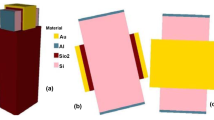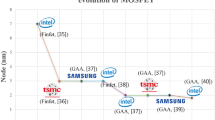Abstract
This paper presents the effect of quantum confinement on the potential of short channel mono-layer molybdenum disulfide (MoS2) based transistor using Ritz Galerkin finite element technique. Unlike earlier models, only two iterations are used to obtain the potential. This model makes use of the coupled Poisson-Schrödinger equation by considering quantum mechanical effects for evaluating the potential with the support of Exciton Bohr radius, bandgap, electron energy state, Density of State (DOS), and electron concentration. Furthermore, this coupled equation along with Neumann boundary condition is employed to approximate the wave function of the Schrödinger equation, which is used again in the Poisson equation for calculating the potential. This work accurately predicts the impact of quantum confinement effects in the perpendicular direction of the channel surface.
Similar content being viewed by others
References
Cheng R, jiang S, Chen Y, Liu Y, Weiss N, Cheng H-C, Hao W, Huang Y, Duan X (2014) Few-layer molybdenum disulfide transistors and circuits for high-speed flexible electronics. Nature Commun 5(5143):1–9. https://doi.org/10.1038/ncomms6143
Zhu W, Low T, Lee Y-H, Wang H, Damon BF, Kong J, Xia F, Avouris P (2014) Electronic transport and device prospects of monolayer molybdenum disulphide grown by chemical vapour deposition. Nature Commun 5(3087):151–157. https://doi.org/10.1038/ncomms4087
Sandeep V, Charles Pravin J, Ramesh Babu A, Prajoon P (2020) Impact of AlInN Back-Barrier Over AlGaN/GaN MOS-HEMT With HfO2 dielectric using cubic spline interpolation technique. IEEE Trans Electron Devices 67:3558–3563. https://doi.org/10.1109/TED.2020.3010710
Charles Pravin J, Nirmal D, Prajoon P, Menokey MA, Anuja M (2016) A new drain current model for a dual metal junctionless transistor for enhanced digital circuit performance. IEEE Trans Electron Devices 63(9):3782–3789. https://doi.org/10.1109/TED.2016.2591982
Charles Pravin J, Nirmal D, Prajoon P, Ajayan J (2016) Implementation of nanoscale circuits using dual metal gate engineered nanowire MOSFET with high-k dielectrics for low power applications. Physica E Low Dimens Syst Nanostruct 83:95–100. https://doi.org/10.1016/j.physe.2016.04.017
Chu T, llatikhameneh H, Klimeck G, Rahman R, Chen Z (2015) Electrically tunable bandgaps in bilayer MoS2. Nano Lett 15(12):8000–8007. https://doi.org/10.1021/acs.nanolett.5b03218
Charles Pravin J, Nirmal D, Prajoon P, Mohan Kumar N, Ajayan J (2017) Investigation of 6T SRAM memory circuit using high-k dielectrics based nano scale junctionless transistor. Superlattices Microstruct 104:470–476. https://doi.org/10.1016/j.spmi.2017.03.012
Yuan H-W, Shen H, Li J-J, Shao J, Huang D, Chen Y-F, Wang PF, Ding SJ, Liu W, Chin A, Li M-F (2016) Investigation of traps at MoS2/Al2O3 interface in nMOSFETs by low-frequency noise. IEEE Electron Device Lett 37(4):516–518. https://doi.org/10.1109/LED.2016.2536100
Lam K-T, Cao X, Guo J (2013) Device performance of heterojunction tunneling field-effect transistors based on transition metal dichalcogenide monolayer. IEEE Electron Device Lett 34(10):1331–1333. https://doi.org/10.1109/LED.2013.2277918
Lu S-C, Leburton J-P (2014) Electronic structures of defects and magnetic impurities in MoS2 monolayers. Nanoscale Res Lett 9:1–9. https://doi.org/10.1186/1556-276X-9-676
Yun WS, Han SW, Hong SC, Kim IG, Lee JD (2012) Thickness and strain effects on electronic structures of transition metal dichalcogenides: 2H-MX2 semiconductors (M = Mo, W; X = S, Se, Te). Am Phys Soc 85(1011):033305–1-4 . https://doi.org/10.1103/PhysRevB.85.033305
Suzuki K, Tanaka T, Tosaka Y, Horie H, Arimoto Y (1993) Scaling theory for double-gate SOI MOSFET’s. IEEE Trans Electron Devices 40(12):2326–2329. https://doi.org/10.1109/16.249482
Molina-Sanchez A, Sangalli D, Hummer K, Marini A, Wirtz L (2013) Effect of Spin-orbit interaction on the optical spectra of single layer, double layer, and bulk MoS2. Phys Rev B 88(4):045412–1-6. https://doi.org/10.1103/PhysRevB.88.045412
Saigal N, Sugunakar V, Ghosh S (2016) exciton binding energy in bulk MoS2: A reassessment. Appl Phys Lett 108(13):132105–1-4. https://doi.org/10.1063/1.4945047
Barbagiovanni EG, Lockwood DJ, Simpson PJ, Goncharova LV (2014) Quantum confinement in Si and Ge nanostructures: theory and experiment. Appl Phys Rev 1(1):011302–1-47. https://doi.org/10.1063/1.4835095
Mak KF, Lee C, Hone J, Shan J, Heinz TF (2010) Atomically thin MoS2: a new direct-gap semiconductor. Phys Rev Lett 105(13): 136805-1-4. https://doi.org/10.1103/PhysRevLett.105.136805
Gan ZX, Liu LZ, Wu HY, Hao YL, Shan Y, Wu XL, Chu PK (2015) Quantum Confinement effcts across two-dimensional planes in MoS2 quantum dots. Appl Phys Lett 106(23):2331137–1-5. https://doi.org/10.1063/1.4922551
Sabyasachi T, Subhashish D, Rahamana H, Guptaa PS (2017) Effect of Temperature and phonon scattering on the Drain current of a MOSFET using SL-MoS2 as its channel material. https://doi.org/10.1016/j.spmi.2017.07.051, vol 111, pp 912–921
Dawei Z, Hao Z, Zhiping Y, Lilin T (2005) A unified charge model comprising both 2D quntum mechanical effects in channels and in poly-silicon gates of MOSFETs. Solid-State Electron 49(10):1581–1588. https://doi.org/10.1016/j.sse.2005.07.026
Jeyadeva GS, Gupta AD (2009) Compact model of short-channel MOSFETs considering quantum mechanical effects. Solid-State Electron 53(6):649–657. https://doi.org/10.1016/j.sse.2009.03.020
González G (2012) Relation between poisson and schrödinger equations. Am J Phys 80 (8):715–719. https://doi.org/10.1119/1.4722788
Patriarca M (1994) Boundary conditions for the schrödinger equation in the numerical simulation of quantum systems. Phys Rev 50:1616–1622. https://doi.org/10.1103/PhysRevE.50.1616
Tomasz J, Bogdan M (1998) Analysis of the MOS transistor based on the self-consistent solution to the schrödinger and poisson equations and on the local mobility model. IEEE Trans Electron Devices 45 (6):1263–1271. https://doi.org/10.1109/16.678531
Padmanaban B, Ramesh R, Nirmal D, Sathiyamoorthy S (2015) Numerical modeling of triple material gate stack gate all-around (TMGSGAA) MOSFET considering quantum mechanical effects. Superlattices Microstruct 82:40–54. https://doi.org/10.1016/j.spmi.2015.01.021
Cao W, Kang J, Liu W, Banerjee K (2014) A compact Current-Voltage model for 2D semiconductor based Field-Effect transistors considering interface traps, mobility degradation, and inefficient doping effect. IEEE Trans Electron Devices 61(12):4282–4290. https://doi.org/10.1109/TED.2014.2365028
Thomee V (2006) Galerkin finite element methods for parabolic problems. Springer series in Computational Mathematics, ISBN:3540331212
Jain MK (1984) Numerical solution of differential equations:(2nd Ed). John Wiley, and Sons Ltd
Rahman E, Shadman A, Ahmed I, Khan SUZ, Khosru1 QDM (2018) A physically based compact IV model for monolayer TMDC channel MOSFET and DMFET biosensor. Nanotech 29(23). https://doi.org/10.1088/1361-6528/aab5ac
Acknowledgments
The authors are grateful to Centre for VLSI Design, Department of Electronics and Communication Engineering, Kalasalingam Academy of Research and Education (KARE) for supporting this research.
Author information
Authors and Affiliations
Contributions
All authors were a major contributor in writing the manuscript.
Corresponding author
Ethics declarations
Competing Interests
The authors have declared that no competing interests exist.
Additional information
Publisher’s Note
Springer Nature remains neutral with regard to jurisdictional claims in published maps and institutional affiliations.
Rights and permissions
About this article
Cite this article
Sridevi, R., Pravin, J.C., Babu, A.R. et al. Investigation of Quantum Confinement Effects on Molybdenum Disulfide (MoS2) Based Transistor Using Ritz Galerkin Finite Element Technique. Silicon 14, 2157–2163 (2022). https://doi.org/10.1007/s12633-021-01010-w
Received:
Accepted:
Published:
Issue Date:
DOI: https://doi.org/10.1007/s12633-021-01010-w




